Page 65 of 122
2001 VOLVO V70
http://new.volvocars.com/ownersdocs/2001/2001_V70/01v70_06a.htm[4/4/2013 10:38:53 PM]
Contents | Top of Page
ProCarManuals.com
Page 66 of 122
![VOLVO V70 2001 Owners Manual 2001 VOLVO V70
http://new.volvocars.com/ownersdocs/2001/2001_V70/01v70_07.htm[4/4/2013 10:38:59 PM]
2 0 0 1
VOLVO V70
Chapter 7 - Wheels and tires
pg. 99 Wheels and tires
General information, Wear i VOLVO V70 2001 Owners Manual 2001 VOLVO V70
http://new.volvocars.com/ownersdocs/2001/2001_V70/01v70_07.htm[4/4/2013 10:38:59 PM]
2 0 0 1
VOLVO V70
Chapter 7 - Wheels and tires
pg. 99 Wheels and tires
General information, Wear i](/manual-img/45/58545/w960_58545-65.png)
2001 VOLVO V70
http://new.volvocars.com/ownersdocs/2001/2001_V70/01v70_07.htm[4/4/2013 10:38:59 PM]
2 0 0 1
VOLVO V70
Chapter 7 - Wheels and tires
pg. 99 Wheels and tires
General information, Wear indicator, Tire economy, Flat spots100
Wheels and tires - All Wheel Drive vehicles101
Snow chains, Snow tires/studded tires102
Inflation pressure, Vehicle loading, Spare tire103
Uniform tire quality grading104
Changing wheels105
pg. 100 Wheels and tires
General information
Your vehicle is equipped with tires according to the tire information label on the inside of the fuel filler door.
The following is an example of a tire designation code: 225/55 R16
225 = tire width in mm.
55 = tire profile. This is the relationship (in percent) between the section height and width of the tire.
R = radial tires.
16 = diameter in inches.
The tires have good road holding characteristics and offer good handling on dry and wet surfaces. It should be noted
however that the tires have been developed to give these features on snow/ice-free surfaces. Certain models are
equipped with "all-season" tires, which provide a somewhat higher degree of road holding on slippery surfaces
than tires without the "all-season" rating. However, for optimum road holding on icy or snow covered roads - we
recommend suitable winter tires on all four wheels . When replacing tires, be sure that the new tires are the same
dimensions, type (radial) and preferably from the same manufacturer, on all four wheels. Do not use bias ply tires.
Otherwise there is a risk of altering the car's roadholding and handling characteristics.
NOTE: When storing wheel/tire assemblies (e.g. snow tires and wheels), either stand the assemblies upright, or
suspend them off the ground. Laying wheel/tire assemblies on their sides for prolonged periods can cause wheel and/or
tire damage.
Wear indicator
The tires have wear indicator strips running across or parallel to the tread. When approx. 1/16" (1.6 mm) is left on the
ProCarManuals.com
Page 67 of 122
![VOLVO V70 2001 Owners Manual 2001 VOLVO V70
http://new.volvocars.com/ownersdocs/2001/2001_V70/01v70_07.htm[4/4/2013 10:38:59 PM]
tread, these strips become visible and indicate that the tire should be replaced.
Tires with less VOLVO V70 2001 Owners Manual 2001 VOLVO V70
http://new.volvocars.com/ownersdocs/2001/2001_V70/01v70_07.htm[4/4/2013 10:38:59 PM]
tread, these strips become visible and indicate that the tire should be replaced.
Tires with less](/manual-img/45/58545/w960_58545-66.png)
2001 VOLVO V70
http://new.volvocars.com/ownersdocs/2001/2001_V70/01v70_07.htm[4/4/2013 10:38:59 PM]
tread, these strips become visible and indicate that the tire should be replaced.
Tires with less than 1/16" (1.6 mm) tread have very poor grip in rain or snow.
To improve tire economy:
Maintain correct tire pressure. See the tire pressure label on the inside of the fuel filler door.
Drive smoothly: avoid fast starts, hard braking and tire screeching.
Tire wear increases with speed.
Correct front wheel alignment is very important.
Unbalanced wheels impair tire economy and driving comfort.
Volvo does not recommend rotating the tires. However, if tires are rotated, they must be kept on the same side of the
car so that they revolve in the same direction as before rotation.
Hitting curbs or potholes can damage the tires and/or wheels permanently.
Flat spots
All tires become warm during use. After cooling, when the vehicle is parked, the tires have a tendency to distort
slightly, forming flat spots. These flat spots can cause vibrations similar to the vibrations caused by unbalanced wheels.
They do, however, disappear when the tire warms up. The degree to which flat spots form depends on the type of cord
used in the tire. Remember that, in cold weather, it takes longer for the tire to warm up and consequently longer for the
flat spot to disappear.
CAUTION: Cars equipped with All Wheel Drive
The car must not be driven with wheels of different dimensions/ specifications or with a spare tire other than the one
that came with the car. The use of different size wheels can seriously damage your car's transmission.
Driving with the temporary spare tire at speeds above 50 mph (80 km/h) can reduce the service life of transmission
components. Do not drive farther than 50 miles (80 km) on a temporary spare tire.
When one or more tires is replaced, the new tire(s) should be mounted on the front wheels. The tires with the least
amount of tread should be mounted on the rear wheels.
pg. 101 Wheels and tires - All Wheel Drive vehicles
Types of Tires
Always drive on tires of identical brand, size, construction (radial), tread pattern, load-, speed-, traction-, temperature-,
and treadwear rating. Never drive on mixed tires, except for brief periods when the temporary spare tire is in use.
Always use properly inflated tires of correct dimensions. Tire size and inflation pressures are shown on the tire
pressure label located inside the fuel filler door.
CAUTION:
Failure to always drive on properly inflated, identical tires of correct dimensions may result in a circumference
difference between tires on the front and rear axles. This will cause excessive tire wear and may damage the
transmission and all-wheel-drive system.
ProCarManuals.com
Page 68 of 122
![VOLVO V70 2001 Owners Manual 2001 VOLVO V70
http://new.volvocars.com/ownersdocs/2001/2001_V70/01v70_07.htm[4/4/2013 10:38:59 PM]
Tire Replacement
When tire replacement is necessary, Volvo strongly recommends replacing all four VOLVO V70 2001 Owners Manual 2001 VOLVO V70
http://new.volvocars.com/ownersdocs/2001/2001_V70/01v70_07.htm[4/4/2013 10:38:59 PM]
Tire Replacement
When tire replacement is necessary, Volvo strongly recommends replacing all four](/manual-img/45/58545/w960_58545-67.png)
2001 VOLVO V70
http://new.volvocars.com/ownersdocs/2001/2001_V70/01v70_07.htm[4/4/2013 10:38:59 PM]
Tire Replacement
When tire replacement is necessary, Volvo strongly recommends replacing all four tires at the same time with identical
tires as explained above. Failure to do so can result in a circumference difference that may damage the transmission
and all-wheel-drive system.
If only one or two tires are replaced, the new tire(s) must be identical to the tires with which the car was built, and
must be mounted on the FRONT AXLE ONLY! Failure to do this may damage the transmission and all-wheel-drive
system.
Tire Rotation
Volvo recommends rotating the tires every 7,500 miles (12,000 km). Tires should be rotated front -to-back/back-to-
front only. Tires must maintain the same direction of rotation throughout their lifetime, and should never be rotated
from one side of the vehicle to the other.
CAUTION:
Failure to rotate tires at recommended intervals will cause uneven tire wear and may damage the transmission and all-
wheel-drive system.
Temporary Spare
The temporary spare tire is for temporary, low-speed, short-distance use only. Replace it with a full-sized tire as soon
as possible, in accordance with "Tire Rotation" above. Do not drive on the temporary spare at speeds above 50 mph
(80km/h) or for distances greater than 50 miles (80 km). Transmission and all-wheel-drive system damage may result.
Never install snow chains on a temporary spare.
pg. 102 Wheels and tires
Snow chains
Snow chains can be used on your Volvo with the following restrictions:
Snow chains should be installed on front wheels only. Use only Volvo approved snow chains.
Special snow chains must be mounted on 215/55 R16. Consult your Volvo retailer.
If accessory, aftermarket or "custom" tires and wheels are installed and are of a size different than the original tires
and wheels, chains in some cases CANNOT be used. Sufficient clearances between chains and brakes, suspension and
body components must be maintained. Snow chains cannot be used on 17" wheels.
Some strap -on type chains will interfere with brake components and therefore CANNOT be used. Consult your
Volvo retailer for additional snow chain information.
CAUTION:
Check local regulations regarding the use of snow chains before installing.
Always follow the chain manufacturer's installation instructions carefully. Install chains as tightly as possible and
retighten periodi-cally.
Never exceed the chain manufacturer's specified maximum speed limit. In no case should you exceed 31 mph (50
km/h).
Avoid bumps, holes or sharp turns when driving with snow chains.
ProCarManuals.com
Page 69 of 122
![VOLVO V70 2001 Owners Manual 2001 VOLVO V70
http://new.volvocars.com/ownersdocs/2001/2001_V70/01v70_07.htm[4/4/2013 10:38:59 PM]
Vehicle handling can be adversely affected when driving with chains. Avoid fast maneuvering and h VOLVO V70 2001 Owners Manual 2001 VOLVO V70
http://new.volvocars.com/ownersdocs/2001/2001_V70/01v70_07.htm[4/4/2013 10:38:59 PM]
Vehicle handling can be adversely affected when driving with chains. Avoid fast maneuvering and h](/manual-img/45/58545/w960_58545-68.png)
2001 VOLVO V70
http://new.volvocars.com/ownersdocs/2001/2001_V70/01v70_07.htm[4/4/2013 10:38:59 PM]
Vehicle handling can be adversely affected when driving with chains. Avoid fast maneuvering and hard braking.
Never allow the wheels to lock up during braking.
Snow tires, studded tires *
Tires for winter use:
Owners who live in or regularly travel through areas with sustained periods of snow or icy driving conditions
are strongly advised to fit suitable winter tires to help retain the highest degree of traction. It is important to
install winter tires on all four wheels to help retain traction during cornering, braking, and accelerating. Failure to do so
could reduce traction to an unsafe level or adversely affect handling. Volvo does not recommend tire rotation.
However, as with any other radial tires, if rotated, the tires must be kept on the same side of the car so that they
revolve in the same direction as before rotation.
Volvo recommends 195/65 R15 snow tires on non-turbo models. Turbo models should be equipped with 205/55
R16 snow tires on all four wheels (215/65 R16 tires should be used on the V70 XC).
Winter tires wear more quickly on dry roads in warm weather. They should be removed when the winter driving
season has ended.
Studded tires should be run-in 300-600 miles (500-1000 km) during which the car should be driven as smoothly as
possible to give the studs the opportunity to seat properly in the tires. The tires should have the same rotational
direction throughout their entire lifetime. In other words, if you wish to rotate the wheels, make sure that the same
wheels are always on the same side of the car.
NOTE: Please consult state or provincial regulations restricting the use of studded winter tires before installing such
tires.
* Where permitted.
pg. 103 Wheels and tires
Checking and correcting tire pressure
Check the tire pressure regularly.
The tire pressure should be corrected only when the tires are cold.
With warm tires, correct only when the pressure is too low. The tire temperature rises after driving just a few miles.
ProCarManuals.com
Page 70 of 122
![VOLVO V70 2001 Owners Manual 2001 VOLVO V70
http://new.volvocars.com/ownersdocs/2001/2001_V70/01v70_07.htm[4/4/2013 10:38:59 PM]
Vehicle loading
The tires on your Volvo should perform to specifications at all normal loads when in VOLVO V70 2001 Owners Manual 2001 VOLVO V70
http://new.volvocars.com/ownersdocs/2001/2001_V70/01v70_07.htm[4/4/2013 10:38:59 PM]
Vehicle loading
The tires on your Volvo should perform to specifications at all normal loads when in](/manual-img/45/58545/w960_58545-69.png)
2001 VOLVO V70
http://new.volvocars.com/ownersdocs/2001/2001_V70/01v70_07.htm[4/4/2013 10:38:59 PM]
Vehicle loading
The tires on your Volvo should perform to specifications at all normal loads when inflated as recommended on the tire
informa-tion label. The label is located on the inside of the fuel filler door. The label lists both tire and vehicle design
limits. Do not load your car beyond the load limits indicated.
WARNING!
Improperly inflated tires will reduce tire life, adversely affect vehicle handling and can possibly lead to failure
resulting in loss of vehicle control without prior warning.
Temporary Spare
The spare tire in your car is called a "Temporary Spare". It has the following designation: T125/80 R17 (T135/90 R17
on the V70 XC).
At the recommended tire pressure shown on the inside of the fuel filler door, the tire may be used as a temporary
replacement for a front or rear tire.
In the event of damage to this tire, a new one can be purchased from your Volvo retailer.WARNING!
Current legislation prohibits the use of the "Temporary Spare" tire other than as a temporary replacement for a
punctured tire. It must be replaced as soon as possible by a standard tire. Road holding and handling may be affected
with the "Temporary Spare" in use. Do not exceed 50 mph (80 km/h). Do not drive farther than 50 miles (80 km) on
a temporary spare tire.
All Wheel Drive models: Driving with the "Temporary Spare" at speeds above 50 mph (80 kph) can lead to excessive
wear on transmission components.
CAUTION:
The car must not be driven with wheels of different dimensions or with a spare tire other than the one that came with
the car. The use of different size wheels can seriously damage your car's transmission.
NOTE: Certain models may be equipped with a full-size spare tire. When used, it should be inflated to the same
pressure as the tire it is replacing.
pg. 104 Wheels and tires
Uniform tire quality grading
ALL PASSENGER CAR TIRES MUST CONFORM TO FEDERAL SAFETY REQUIREMENTS IN
ADDITION TO THESE GRADES
Quality grades can be found, where applicable, on the tire sidewall between the tread shoulder and maximum section
width. For example:
Treadwear 200 Traction AA Temperature A
TREADWEAR
ProCarManuals.com
Page 71 of 122
![VOLVO V70 2001 Owners Manual 2001 VOLVO V70
http://new.volvocars.com/ownersdocs/2001/2001_V70/01v70_07.htm[4/4/2013 10:38:59 PM]
The treadwear grade is a comparative rating based on the wear rate of the tire when tested under VOLVO V70 2001 Owners Manual 2001 VOLVO V70
http://new.volvocars.com/ownersdocs/2001/2001_V70/01v70_07.htm[4/4/2013 10:38:59 PM]
The treadwear grade is a comparative rating based on the wear rate of the tire when tested under](/manual-img/45/58545/w960_58545-70.png)
2001 VOLVO V70
http://new.volvocars.com/ownersdocs/2001/2001_V70/01v70_07.htm[4/4/2013 10:38:59 PM]
The treadwear grade is a comparative rating based on the wear rate of the tire when tested under controlled conditions
on a specified govern-ment test course. For example, a tire graded 150 would wear one and one half (1 1/2) times as
well on the government course as a tire graded 100. The relative performance of tires depends upon the actual
conditions of their use, however, and many depart significantly from the norm due to variation in driving habits,
service practices and differences in road characteristics and climate.
TRACTION
The traction grades, from highest to lowest, are AA, A, B, and C, as measured under controlled conditions on specified
government test surfaces of asphalt and concrete. A tire marked C may have poor traction performance.
WARNING!
The traction grade assigned to this tire is based on braking (straight-ahead) traction tests and is not a measure of
cornering (turning) traction.
TEMPERATURE
The temperature grades are AA (the highest), A, B, and C, representing the tire's resistance to the generation of heat
and its ability to dissipate heat when tested under controlled conditions on a specified indoor laboratory test wheel.
Sustained high temperature can cause the material of the tire to degenerate and reduce tire life, and excessive
temperature can lead to sudden tire failure. The grade C corresponds to a minimum level of performance which all
passenger car tires must meet under the Federal Motor Safety Standard No. 109. Grades B and A represent higher
levels of performance on the laboratory test wheel than the minimum required by law. WARNING!
The temperature grade for this tire is established for a tire that is properly inflated and not overloaded. Excessive
speed, under-inflation, or excessive loading, either separately or in combination, can cause heat buildup and possible
tire failure.
pg. 105 Changing wheels
Changing wheels
The spare wheel is located under the carpet on the cargo area floor. The jack and crank are secured in the wheel recess.
There are two jack attachment points on each side of the car.
To change a wheel:
ProCarManuals.com
Page 72 of 122
![VOLVO V70 2001 Owners Manual 2001 VOLVO V70
http://new.volvocars.com/ownersdocs/2001/2001_V70/01v70_07.htm[4/4/2013 10:38:59 PM]
Engage the parking brake.
Put the gear selector in (P)ark.
Remove the wheel cap (where applicable) VOLVO V70 2001 Owners Manual 2001 VOLVO V70
http://new.volvocars.com/ownersdocs/2001/2001_V70/01v70_07.htm[4/4/2013 10:38:59 PM]
Engage the parking brake.
Put the gear selector in (P)ark.
Remove the wheel cap (where applicable)](/manual-img/45/58545/w960_58545-71.png)
2001 VOLVO V70
http://new.volvocars.com/ownersdocs/2001/2001_V70/01v70_07.htm[4/4/2013 10:38:59 PM]
Engage the parking brake.
Put the gear selector in (P)ark.
Remove the wheel cap (where applicable) using the lug wrench in the tool kit.
With the car still on the ground, use the lug wrench to loosen the wheel bolts 1/2 - 1 turn. Turn the bolts
counterclockwise to loosen.
Position the jack on the bar in the attach-ment (A in the illustration in right column) and crank while simultaneously
guiding the base of the jack to the ground. The base of the jack must be flat on a level, firm, non-slippery surface.
Before raising the car, check that the jack is still correctly positioned in the attach-ment.
Raise the vehicle until the wheel to be changed is lifted off the ground.
Unscrew the wheel bolts completely and carefully remove the wheel so as not to damage the thread on the studs.
NOTE: See also page 127
for hoisting the vehicle on a garage lift!
WARNING!
The jack must correctly engage the bar in the jack attachment (A). The car's weight must not rest on the jack
attachment (B). See illustration on page 106.
Be sure the jack is on a firm, level, non-slippery surface.
Never allow any part of your body to be extended under a car supported by a jack.
Use the jack intended for the car when replacing a wheel. For any other job, use stands to support the side of the
car being worked on.
Apply the parking brake and put the gear selector in the (P)ark position.
Block the wheels standing on the ground, use rigid wooden blocks or
pg. 106 Wheels and tires
ProCarManuals.com
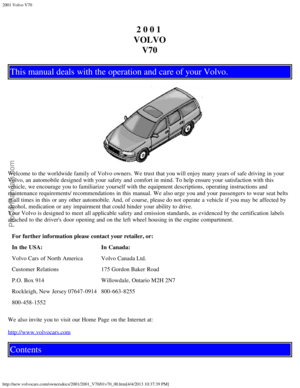 1
1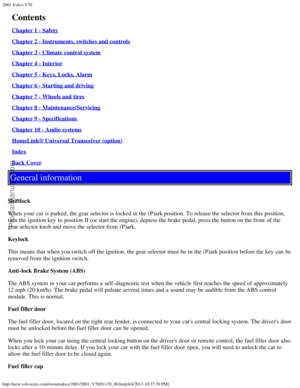 2
2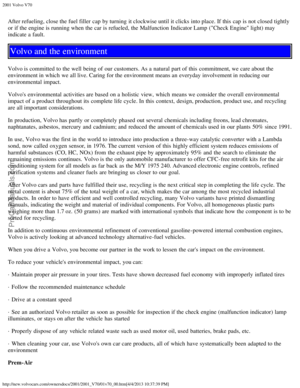 3
3 4
4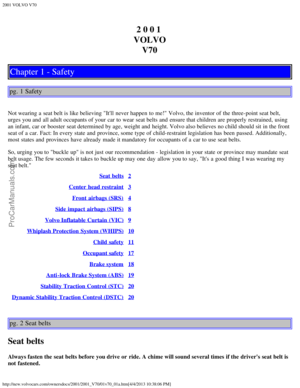 5
5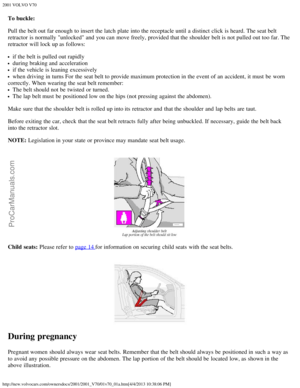 6
6 7
7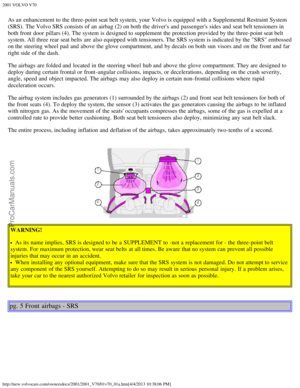 8
8 9
9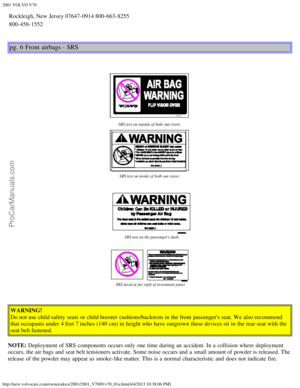 10
10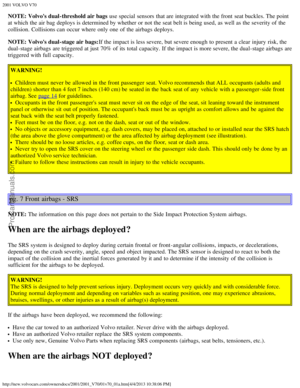 11
11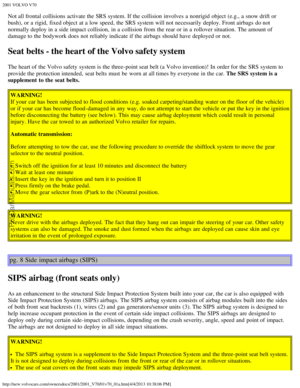 12
12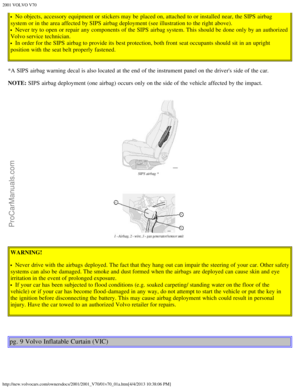 13
13 14
14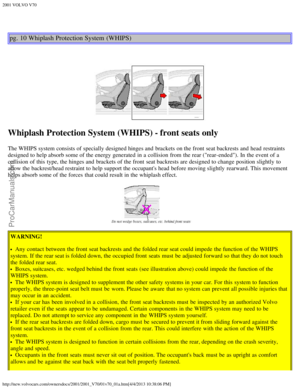 15
15 16
16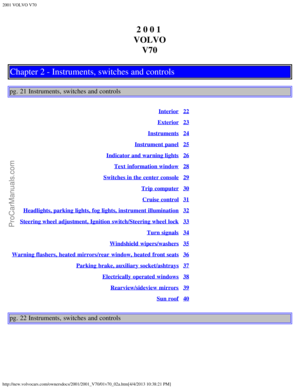 17
17 18
18 19
19 20
20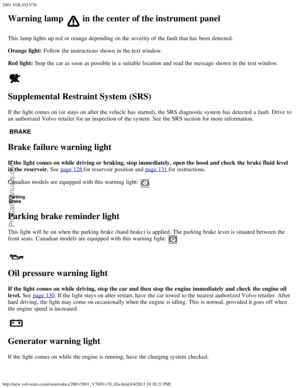 21
21 22
22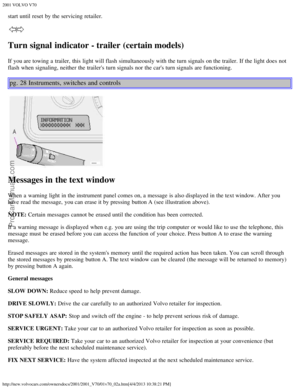 23
23 24
24 25
25 26
26 27
27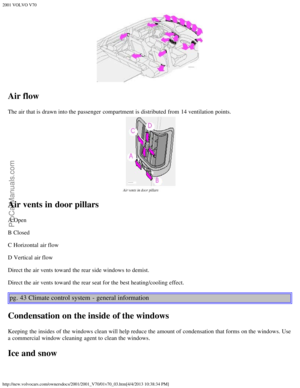 28
28 29
29 30
30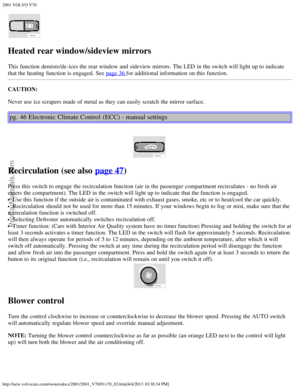 31
31 32
32 33
33 34
34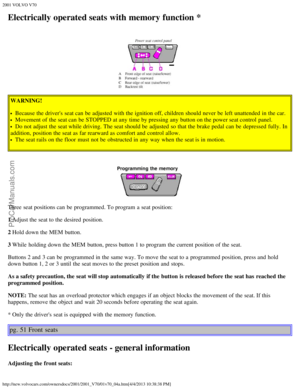 35
35 36
36 37
37 38
38 39
39 40
40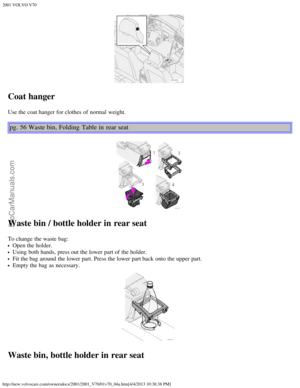 41
41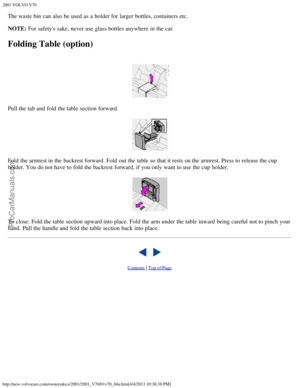 42
42 43
43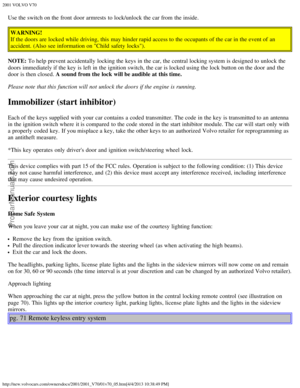 44
44 45
45 46
46 47
47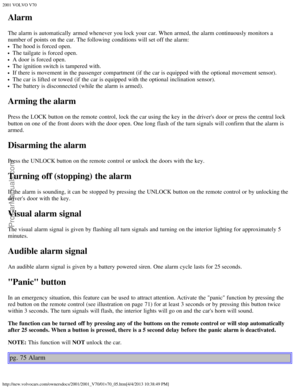 48
48 49
49 50
50 51
51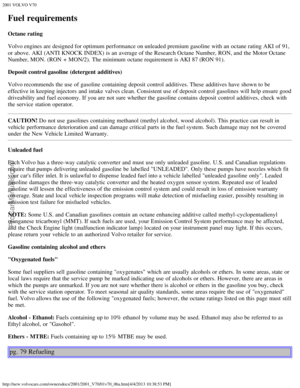 52
52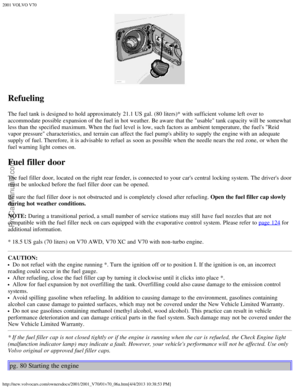 53
53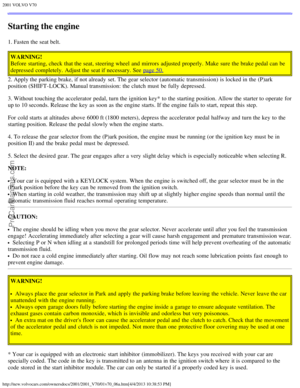 54
54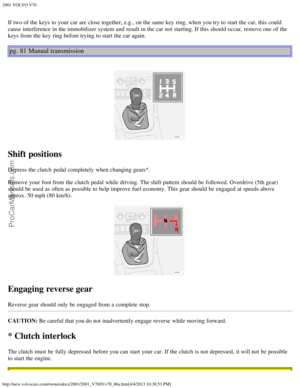 55
55 56
56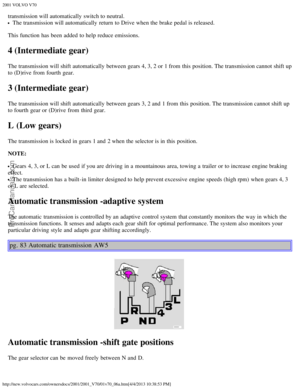 57
57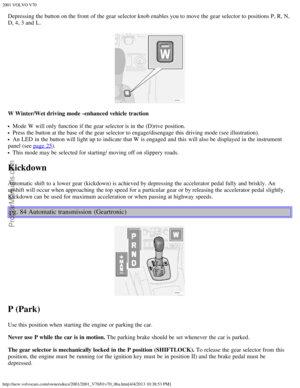 58
58 59
59 60
60 61
61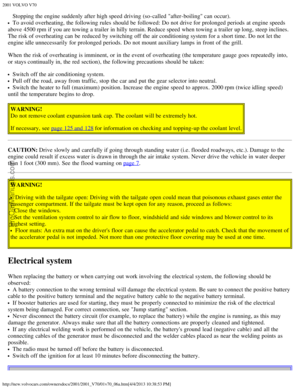 62
62 63
63 64
64 65
65 66
66 67
67 68
68 69
69 70
70 71
71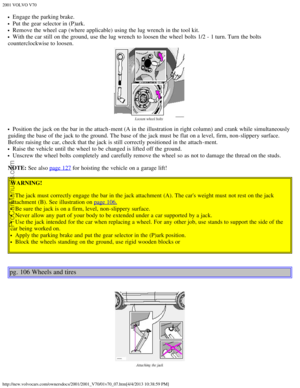 72
72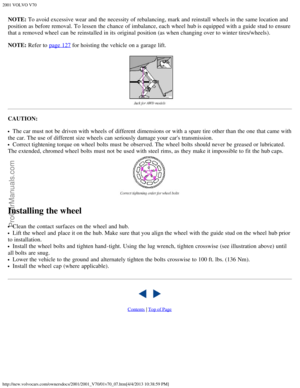 73
73 74
74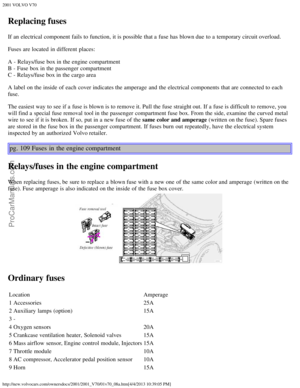 75
75 76
76 77
77 78
78 79
79 80
80 81
81 82
82 83
83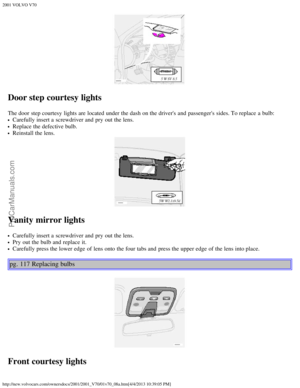 84
84 85
85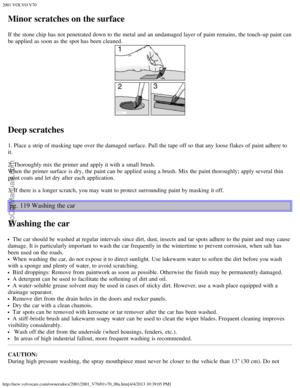 86
86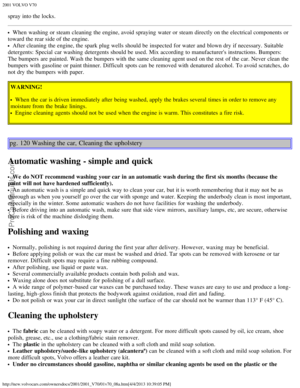 87
87 88
88 89
89 90
90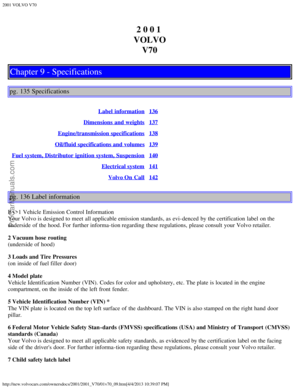 91
91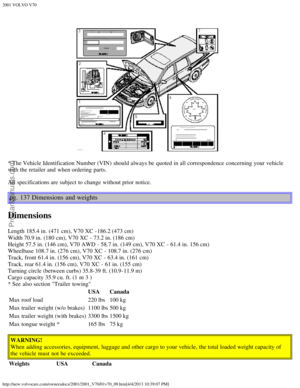 92
92 93
93 94
94 95
95 96
96 97
97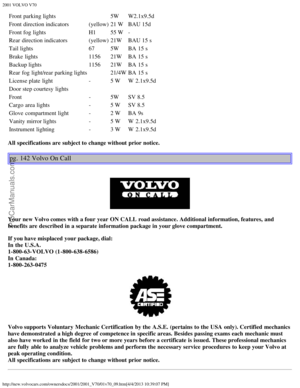 98
98 99
99 100
100 101
101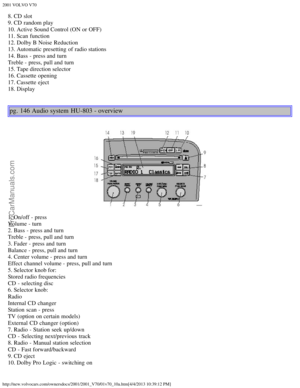 102
102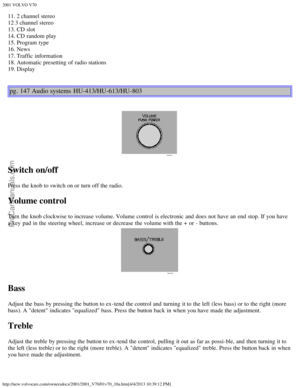 103
103 104
104 105
105 106
106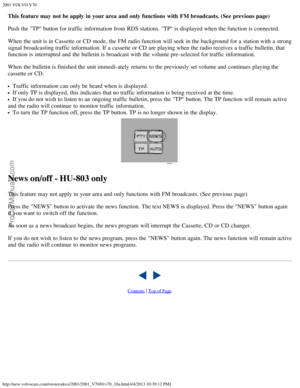 107
107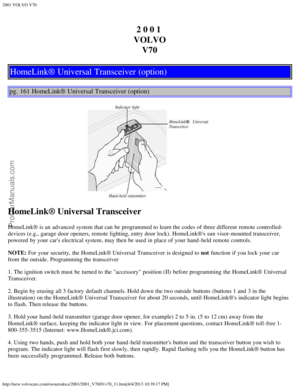 108
108 109
109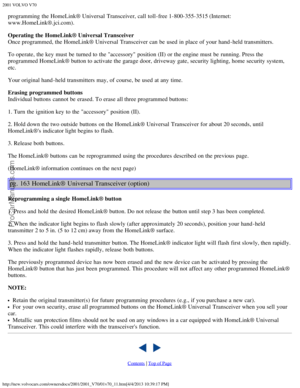 110
110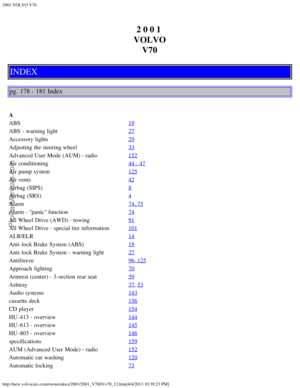 111
111 112
112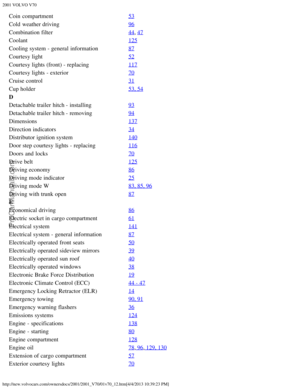 113
113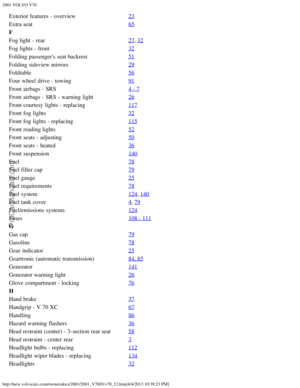 114
114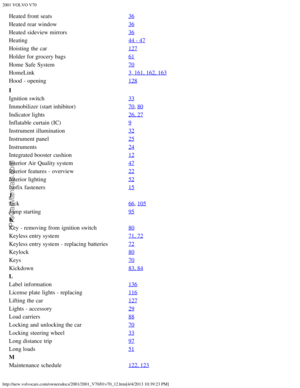 115
115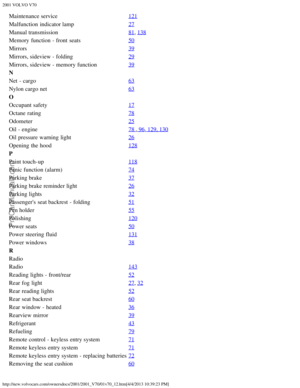 116
116 117
117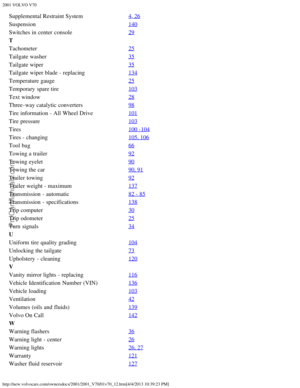 118
118 119
119 120
120 121
121![VOLVO V70 2001 Owners Manual 2001 VOLVO V70
http://new.volvocars.com/ownersdocs/2001/2001_V70/01v70_06a.htm[4/4/2013 10:38:53 PM]
Contents | Top of Page
ProCarManuals.com VOLVO V70 2001 Owners Manual 2001 VOLVO V70
http://new.volvocars.com/ownersdocs/2001/2001_V70/01v70_06a.htm[4/4/2013 10:38:53 PM]
Contents | Top of Page
ProCarManuals.com](/manual-img/45/58545/w960_58545-64.png)
![VOLVO V70 2001 Owners Manual 2001 VOLVO V70
http://new.volvocars.com/ownersdocs/2001/2001_V70/01v70_07.htm[4/4/2013 10:38:59 PM]
2 0 0 1
VOLVO V70
Chapter 7 - Wheels and tires
pg. 99 Wheels and tires
General information, Wear i VOLVO V70 2001 Owners Manual 2001 VOLVO V70
http://new.volvocars.com/ownersdocs/2001/2001_V70/01v70_07.htm[4/4/2013 10:38:59 PM]
2 0 0 1
VOLVO V70
Chapter 7 - Wheels and tires
pg. 99 Wheels and tires
General information, Wear i](/manual-img/45/58545/w960_58545-65.png)
![VOLVO V70 2001 Owners Manual 2001 VOLVO V70
http://new.volvocars.com/ownersdocs/2001/2001_V70/01v70_07.htm[4/4/2013 10:38:59 PM]
tread, these strips become visible and indicate that the tire should be replaced.
Tires with less VOLVO V70 2001 Owners Manual 2001 VOLVO V70
http://new.volvocars.com/ownersdocs/2001/2001_V70/01v70_07.htm[4/4/2013 10:38:59 PM]
tread, these strips become visible and indicate that the tire should be replaced.
Tires with less](/manual-img/45/58545/w960_58545-66.png)
![VOLVO V70 2001 Owners Manual 2001 VOLVO V70
http://new.volvocars.com/ownersdocs/2001/2001_V70/01v70_07.htm[4/4/2013 10:38:59 PM]
Tire Replacement
When tire replacement is necessary, Volvo strongly recommends replacing all four VOLVO V70 2001 Owners Manual 2001 VOLVO V70
http://new.volvocars.com/ownersdocs/2001/2001_V70/01v70_07.htm[4/4/2013 10:38:59 PM]
Tire Replacement
When tire replacement is necessary, Volvo strongly recommends replacing all four](/manual-img/45/58545/w960_58545-67.png)
![VOLVO V70 2001 Owners Manual 2001 VOLVO V70
http://new.volvocars.com/ownersdocs/2001/2001_V70/01v70_07.htm[4/4/2013 10:38:59 PM]
Vehicle handling can be adversely affected when driving with chains. Avoid fast maneuvering and h VOLVO V70 2001 Owners Manual 2001 VOLVO V70
http://new.volvocars.com/ownersdocs/2001/2001_V70/01v70_07.htm[4/4/2013 10:38:59 PM]
Vehicle handling can be adversely affected when driving with chains. Avoid fast maneuvering and h](/manual-img/45/58545/w960_58545-68.png)
![VOLVO V70 2001 Owners Manual 2001 VOLVO V70
http://new.volvocars.com/ownersdocs/2001/2001_V70/01v70_07.htm[4/4/2013 10:38:59 PM]
Vehicle loading
The tires on your Volvo should perform to specifications at all normal loads when in VOLVO V70 2001 Owners Manual 2001 VOLVO V70
http://new.volvocars.com/ownersdocs/2001/2001_V70/01v70_07.htm[4/4/2013 10:38:59 PM]
Vehicle loading
The tires on your Volvo should perform to specifications at all normal loads when in](/manual-img/45/58545/w960_58545-69.png)
![VOLVO V70 2001 Owners Manual 2001 VOLVO V70
http://new.volvocars.com/ownersdocs/2001/2001_V70/01v70_07.htm[4/4/2013 10:38:59 PM]
The treadwear grade is a comparative rating based on the wear rate of the tire when tested under VOLVO V70 2001 Owners Manual 2001 VOLVO V70
http://new.volvocars.com/ownersdocs/2001/2001_V70/01v70_07.htm[4/4/2013 10:38:59 PM]
The treadwear grade is a comparative rating based on the wear rate of the tire when tested under](/manual-img/45/58545/w960_58545-70.png)
![VOLVO V70 2001 Owners Manual 2001 VOLVO V70
http://new.volvocars.com/ownersdocs/2001/2001_V70/01v70_07.htm[4/4/2013 10:38:59 PM]
Engage the parking brake.
Put the gear selector in (P)ark.
Remove the wheel cap (where applicable) VOLVO V70 2001 Owners Manual 2001 VOLVO V70
http://new.volvocars.com/ownersdocs/2001/2001_V70/01v70_07.htm[4/4/2013 10:38:59 PM]
Engage the parking brake.
Put the gear selector in (P)ark.
Remove the wheel cap (where applicable)](/manual-img/45/58545/w960_58545-71.png)